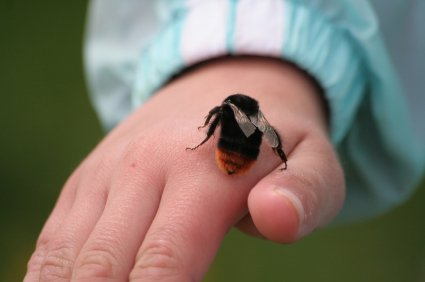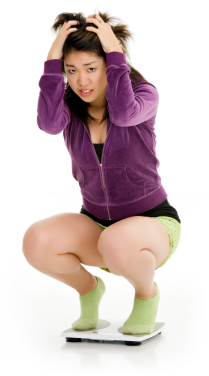By Michelle Donaghey
Summer. The season of fun-filled days spent outdoors at the beach, pool, backyard and parks. While the weather is warm and the kids want to spend every waking moment out of the house, make sure that as a parent you are ready to take care of any summertime “emergency” that can happen without a moment’s notice.
STINGS! Yikes!!
 If it hasn’t happened at your house, it will most likely at sometime during the time your children are still at home. Often, stings from bees and or wasps can easily be prevented with a little awareness and care.
If it hasn’t happened at your house, it will most likely at sometime during the time your children are still at home. Often, stings from bees and or wasps can easily be prevented with a little awareness and care.
In order to prevent a sting from happening, the first thing you should do is to make sure your kids always have footwear on! Most stings happen when a person steps on a bee with their bare feet, often walking near or through a garden. Be sure to avoid areas where bees and wasps are noticeable.
Don’t have your kids wear bright clothes or clothing with flowery prints! While they may look nicer, they attract bees that are attracted to dark colors and prints. If possible, cover up with clothing. Lightweight cotton is a good choice for summertime.
While you or your child might smell good, don’t use any kind of soaps, perfumes, scented powders or hairsprays or gels. They attract winged creatures! Do not think that insect repellents will protect you from stings! They are not made to do so.
If you or your child is being chased by a bee or a wasp, DON’T yell or make a big commotion! This only annoys and scares the bees and wasps. Be calm!
Your child is stung!!
The first rule of thumb is to NOT pull out the stinger. The stinger holds the venom which causes the hurt. If you wonder what the stinger looks like, it looks like a small black dot which often will start to show red around it right after someone is stung. To take out the stinger, use a scraping motion with credit card or the back of your thumbnail or a dull knife. While it may be tempting, DO NOT use tweezers!
After removing the stinger, wash the area with soap and water put an ice cube on the area, but don’t leave it there all the time, but place it on and off. Don’t put meat tenderizer on a sting! Instead, you can make a paste out of water and baking soda.
Usually there will be swelling around the area. If you elevate the area around the sting, you can help to reduce the swelling.
Don’t be alarmed if there is swelling for up to a day, though the pain usually subsides within hours.
Get to the doctor now!
If you child has never been stung, make sure that you watch for signs of an allergic reaction which can include-
Immediate reaction…
A serious reaction that can occur within minutes after the sting is anaphylaxis. According to the American College of Allergy, Asthma and Immunology symptoms may include:
* Dizziness or a sharp drop in blood pressure.
* Unconsciousness or cardiac arrest.
Other reactions that you should contact your doctor include:
* Swelling does continue after 24 hours and/or there is swelling going beyond the area where he or she was stung.
* A rash, hives or swelling in other areas on the body.
* Shortness of breath and or tightness in their chest.
* A swollen tongue and or face.
BUG BITES
The first rule of prevention of bug bites as with bees is that you avoid places there they are. Try to have your kids in the house by dusk and not out of the house until the sun is in the sky. These times are peak times that mosquitoes bite!
Try to wear long-sleeved shirts and long pants even though it is warm outside With babies, be sure to put mosquito netting over their carriers or strollers when you are out of doors. To keep bugs out of your house, install or repair window and door screens so that they cannot get indoors.
Get rid of the standing water whether it is in a birdbath, bucket or sandbox in your yard. Mosquitoes will multiply if these are left alone.
If you LOVE to drink soda pop from cans, be SURE to throw them out in a covered garbage can or in a tied up bag. Bees swarm around sweet smelling things including soda and candies! If you attend your child’s sporting events and goodies are available, try to eat and drink at a table near the concession stand. When choosing a place to sit to watch the game, be sure to find a spot AWAY from the trash can. If you like to drink something while watching, choose bottled water.
Even if you don’t think you or your child might be bitten, if you are going to be outdoors be SURE to apply insect repellent to any areas of exposed skin. Choose a repellent that contains DEET or Picaridin. “ Products containing these active ingredients typically provide longer-lasting protection than others noted the Center for Disease Control.
Do not apply repellents on your child’s palms as they may touch their mouths and face which will cause irritation! If you want to apply it to their face, spray it on your hand and then apply it very carefully, avoiding their mouth and eyes. Do not forget their ears and neck as well!
The CDC notes that it is “recommended NOT to use a single product that combines insect repellent containing DEET and sunscreen, because the instructions for use of insect repellents and use of sunscreen are different. In most situations, insect repellent does not need to be reapplied as frequently as sunscreen.”
The American Academy of Pediatrics notes that the concentration of DEET in products may range from less than 10 percent to over 30 percent. The benefits of DEET reach a peak at a concentration of 30 percent, the maximum concentration currently recommended for infants and children. DEET should not be used on children under 2 months of age.
Remember to re-apply as needed, especially if the bugs bite you. That means that the product as worn off. Check the product for the typical number of hours you should apply it.
Upon returning indoors, be sure to tell your children to wash off!
It ITCHES!!
If your child has been bitten by a mosquito, first wash the bite with soap and water. The next step is to relieve the itching. Put on some calamine lotion to help stop the itching or place an ice pack on the bite.
Sun Safety for the Family from the American Academy of Pediatrics notes that:
- The sun’s rays are the strongest between 10 a.m. and 4 p.m. Try to keep out of the sun during those hours.
- The sun’s damaging UV rays can bounce back from sand, snow or concrete; so be particularly careful of these areas.
- Most of the sun’s rays can come through the clouds on an overcast day; so use sun protection even on cloudy days.
Sunscreen choices do matter!
Remember that when choosing a sunscreen, look for the words "broad-spectrum" on the label – it means that the sunscreen will screen out both ultraviolet B (UVB) and ultraviolet A (UVA) rays. Choose a water-resistant or waterproof sunscreen and reapply every two hours.
The AAP urges that everyone who is out in the sun use:
- Zinc oxide, a very effective sunblock, can be used as extra protection on the nose, cheeks, tops of the ears and on the shoulders.
- A sun protection factor (SPF) of at least 15.
Be sure that you rub sunscreen in well and to make sure to cover all exposed areas, especially the face, nose, ears, feet and hands, and even the backs of the knees. Don’t wait until you are out-of-doors to apply it, but rather put it on 30 minutes before you go outside. Also remember that sunscreens are used for protection from the sun and they are NOT a reason to be outdoors longer than you or your child should be!
Your best and safest defense against sunburn is to make sure that you and your children cover up whenever possible. Wear a hat with a brim or bill that covers your face, sunglasses that block 99-100 percent of ultraviolet rays and cotton clothing.
I can’t hear good!!
My EAR hurts!!
Water in the ear and Swimmer’s Ear-
Every child gets water stuck in their ear if they spend any sort of time in a swimming pool during the summer months. As parents, we often remember having the same thing happen, and often have it happen to ourselves.
Water in the ear-
You or your child can hear it sloshing around, but even when you turn your head to let it drain out, it doesn’t! Water in your ear can easily be prevented if you dry out your ears.
American Academy of Otolaryngology-Head and Neck Surgery notes that it is important to keep the ears free of moisture after swimming or bathing. The AAO notes that removable earplugs, sometimes worn for hearing protection, can be used to keep moisture out of the ear canal. Do not use Q-tips because they may pack material deeper into the ear canal, remove protective earwax, and irritate the thin skin of the ear canal creating the perfect environment for infection notes the AAO which suggests that the safest way to dry your ears is with a hair dryer. If you do not have a perforated eardrum, rubbing alcohol or a 50:50 mixture of alcohol and vinegar used as eardrops will evaporate excess water and keep your ears dry.
Before using any drops in the ear, it is important to verify that you do not have a perforated eardrum. Check with your otolaryngologist if you have ever had a perforated, punctured, or injured eardrum, or if you have had ear surgery.
People with itchy ears, flaky or scaly ears, or extensive earwax are more likely to develop swimmer’s ear. If so, it may be helpful to have your ears cleaned periodically by an otolaryngologist.
Swimmer’s Ear
Swimmer’s Ear is different from water in the ear as it is an infection of the ear and or the outer ear canal. This can cause the ear to hurt even when being touched. There may also be drainage from the ear and itching. If you have pain in your ear and can wiggle the outer ear without pain, you probably don’t have swimmer’s ear.
According to the Center for Disease Control swimmer’s ear is caused by an infection and is caused by contaminated water or from placing contaminated objects in the ear.
A doctor treats swimmer’s ear with antibiotic drops or an antiseptic sponge that is placed in the ear. The doctor will also tell your child that your child should wait a week to 10 days before they can swim again.
In order to prevent swimmer’s ear, the CDC suggests four healthy tips to prevent swimmer’s ear-
- Dry your ears after swimming. If it is difficult to get water out of your ear, apply a few drops of an alcohol-based ear product into the ear. Ask a pharmacist at your local drug store for this product.
- Ask your pool manager about the chlorine and pH testing program at your pool. Pools and hot tubs with good chlorine and pH control are unlikely to spread Swimmer’s Ear.
- Pay attention to signage and avoid swimming in locations that have been closed because of pollution.
- Avoid putting objects in the ear (e.g. fingers, cotton swabs) that may scratch the ear canal and provide a site for infection.
Biography
Michelle Donaghey is a freelance writer and mother of two boys, Chris and Patrick, who are her inspiration. She lives in Bremen, Indiana just south of South Bend, home of Notre Dame. When she isn’t writing, Michelle can be found in her perennial flower garden or working on small home improvement projects. Michelle has written for parenting publications including Metro Kids, Atlanta Parent,Dallas Child, Great Lakes Family, Family Times and Space Coast Parent and websites including iparenting.com.
No part of this article may be copied or reproduced in any form without the express permission of More4Kids Inc © 2007










Add Comment